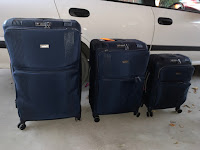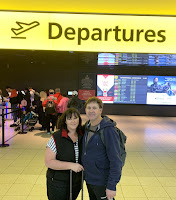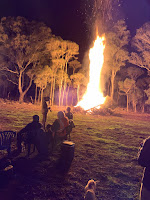Fatigue finally set in after 14 days of travelling. I spent Thursday in a state of continuous tiredness while Daryl was sporting additional baggage under his eyes in support of my own.
We arrived in Scotland late Wednesday night, after an uneventful ferry ride into Cairnryan on the west coast. The ferry, one of the Stena Line fleet, was lovely compared to the one we travelled on to Ireland. Clean, high class food, and only a few hundred travellers, we had a whole area to ourselves and before we knew it the trip was over. The only down side was the very slow wifi. In the end we gave up and simply enjoyed the view. Finding a sweet little hotel we arrived and stayed on the outskirts of Girvan. Never quite knowing what we have booked into, we were pleasantly surprised to find a clean room, with tea/coffee making facilities and shutters to block out the light. Daryl did in fact squeal with joy.
Unfortunately, my efforts to walk mountains in Northern Ireland had caught up with me and I must admit the pain levels increased dramatically, making sleep a challenge. So, a quieter day was in order. Checking out the local town, Girvan, leaves a lot to be desired. Dark and bland streets were littered with rubbish, the waterway emitted a distinctly fishy odour from the docked boats and payment of 30p was required in order to pee. Daryl discovered that it was necessary
to take your wallet to the WC otherwise no entry, no matter how full your bladder. We decided to stroll along the beach and discovered the water of the northern sea was very cold, chilling not only our toes but our bones as well. The sand is a gritty grey, a rather ordinary, poor cousin to our lovely Australian waters. The Girvan coffee is also questionable and it was poured onto an ocean weed after the first hesitant taste. Girvan did nothing to lift our spirits so we moved on in the direction of Culzean Castle and Country Park.
Well the contrast couldn’t be more stark. Enchanting, beautiful and simultaneously horrific the story behind the castle and the people who built it, is intriguing. We spent over two hours wandering the restored rooms and gardens around the castle. National Trust volunteers man each room and provide additional detail to the hundreds of visitors each day. An introduction to the Culzean Castle reads: Present day visitors to Culzean are enchanted by the approach to the castle as, from the top of the hill with its superb panoramic view over the firth of Clyde, the drive
winds through wooded countryside towards the ruined arch and viaduct which leads to the front
door. One can only marvel at its truly spectacular sea. To medieval eyes, however, in a Scotland riven with ferocious and bloody family feuds, the very qualities that make Culzean a scenic delight are the ones that made this site more important tactically. Protected by tall cliffs and the sea on one side and a steep glen on the other, any house built here was a fortress.
Following a lovely morning tea by the sea, we took our weary selves and drove northwards towards Ayr. On the way we were distracted by the Robert Burns Birthplace Museum and decided it was worth a stop. Robert Burns was born in a small cottage in 1759 and became Scotland’s favourite son and national bard - he is described as an extraordinary poet, egalitarian and international icon. His works are the cornerstone of Scotland’s literary heritage and his legacy has held strong for over two centuries. The museum is captivating and the surrounding gardens and walks including the Brig a’doon, very large monument to Burns and his birthplace cottage are worth the time to explore. His story is a colourful one and the museum presents an
in-depth collection of works from his time and life. Every time I sing Auld Lang Syne I will think of my visit here.
By late afternoon we made our way to Glasgow, finding a last minute room on the West Bank in Finnieston. The Hilton Garden Inn, became our base for the next two nights, and again we were blessed with a decent bed, curtains and a laundry. We spent the remainder of the evening washing and drying our clothes. Daryl met a a young man called Jake, from the Isle of Skye, so to the sounds of the washing machine whirring in the background, Jake provided valuable local knowledge and information for the naive travellers. The timing was most fortunate as our intended destination in a few days is the Isle of Skye. The next morning the sun shone brightly over us. The locals told us they rarely see sunshine and so when we arrived with full sun, and warmer than average temperatures, we watched them, with some surprise, bake in any outdoor area they could find. Hundreds of people laid out in parklands, cafes and riversides to catch the
unexpected rays. By the end of our day we saw many red skinned locals who may have underestimated the impact of lounging in the sun unprotected. For the first time since leaving Charles and Karen’s home we didn’t get in the car choosing instead to use the tourist on-off bus around Glasgow. This proved to be a good idea given the vast area this city covers. Neither Daryl nor I fell in love with Glasgow, it’s old buildings are dull and dreary to look at, in need of some cleaning, the rubbish that litters the streets combined with the many homeless sleeping rough made you feel more wary than relaxed. The stark contrast between those that have and those that don’t is clearly defined in this city and this is displayed in the people’s museum of Glasgow. Galsgow developed dramatically on the back of the tobacco trading, ship and locomotive building, all of which thrived thanks to ruthless business men and a slave trade. Recording the history of the development of the city, the museum portrays a hard life for the city’s many residents, thousands who lived in the tenements, apartment style housing that saw up to four
families living in cramped unhygienic conditions in one or two rooms. No running water, no toilet, very communal in nature. Washing was completed in large washing rooms - steam houses and the women who went there became iconically known as “steamies”. The weekly event became the source for not only providing clean clothes for the family, who I might add at this stage rarely bathed, but for gathering of news and gossip of the neighbourhood. A sense of sisterhood was formed by the Steamies, most of whom lived with domestic violence and poverty exacerbated by alcohol abuse and too many children. Some of the tenements are still used today, but with less residents sharing and modern conveniences now added. The culture of drinking to excess is still evident and there are bars and pubs on every street. It was not uncommon to see folk drinking lager with their breakfast. On the flip side the wealthy lived to excess and their homes are resplendent with objects of wealth and convenience for the era. We visited the Town Hall of
Glasgow and if you see the photos you will note the marble staircases which cover three floors.
The opulence is remarkable on one hand, it contains more marble than the Queen’s palace, while outside through heavy, solid carved doors, the poor beg on the streets.
We also toured the Glasgow cathedral and Daryl was amazed that the building didn’t fall in on him and then spent the next hour staring at the ornate ceilings, the decorative stained glasswindows and intricate details that make up the physical structure of this famous church. Worshippers sat in silent reverence while others clicked away furiously on their cameras trying to capture the engineering masterpiece that is this building constructed in the 15th century and is the oldest cathedral on mainland Scotland. The famous Glasgow necropolis is again a vast display of money spent on the dead while the living struggle to feed their children. The cemetery overlooks the river and is grand. Some of the tombs date back so long that the concrete stones no longer reveal those interred. A somber walk up a very steep hill.
After a cup of tea and more food, we noticed a small sign to the Anne Frank exhibition and took a short stroll to visit the centre. Such a sad and tragic display of the plight of Anne Frank and the thousands of Jews persecuted during this time combined with more recent atrocities inflicted on
people based on racism, ignorance and greed. We walked away feeling sad at the capacity of humans to harm and hurt to such lengths; then thankful for the freedom of Australia and the fortune of our families to not endure such conflict.
After a brief, late afternoon reprieve in our room, we ventured out again to experience the Glasgow nightlife and take in some local shopping. The shopping precinct rival Melbourne or Sydney and the streets echoed with the voices and footsteps of thousands of tourists and locals alike on a Friday evening. After supporting the local community, once again purchasing some gifts for those back home, we found a funky little bar, and sampled some of their delights.
Listening to the array of accents we found ourselves, on more than one occasion, requesting the
speaker to repeat their question or comment. It seems we don’t speak Scottish very well. We
walked the Glasgow streets in search of a pub for dinner, by now it was nearly nine o’clock and the sun was still shining brightly. The city has a distinctly working class atmosphere and it seemed the people party hard on a Friday night. Every pub had people on the pavement, the smell of tobacco is strong with more women than men filling the streets with smoke. After sidestepping a small brawl, leaving the drunken man, pinned to the floor, with four others holding him down, we found a smaller, pub just around the corner. It was hot and bursting with people. It had a good feel about it, so we found a corner table, conveniently with a view to the previous scene of the brawl and so could see the ending of the tale with the police called to take the now restrained reveller away. The meal was good hearty pub fair, the drinks were generous and the people good natured. Once we sorted the accents out, Daryl had an enlightening conversation
With the waiter about the steak pie that wasn’t and discovered it is known as a lazy Scottish pie. Essentially slow cooked meat in a tasty sauce with a puff pastry casing set to look like a pie, placed on top of the meat. While Daryl felt a bit ripped off, he ate every morsel without cause for complaint. Ending the night we caught a traditional old style London cab and returned to our hotel. On the way the cab driver, a 75 year old gent, who said he was still driving taxies a couple of hours a week, so he didn’t die young, entertained us with a story about his cousin in Sydney. We tipped him well and it seems he may have been our highlight of Glasgow. A final cocktail, a game of pool and a bizarre dating show called #Naked Attraction finished off our evening.
When the alarm sounded we were pleased to say goodbye to Glasgow and head for the famous Scottish Highlands.
Until next time,
N










